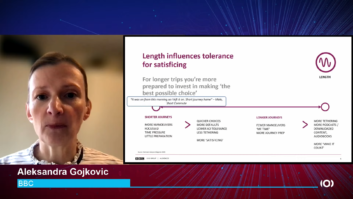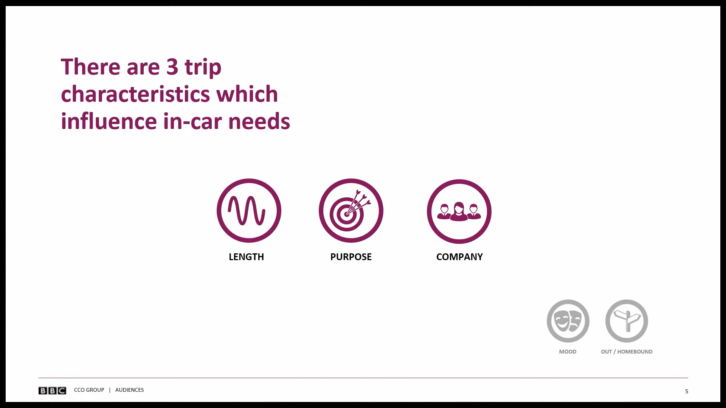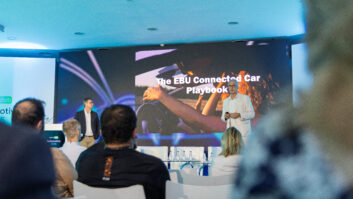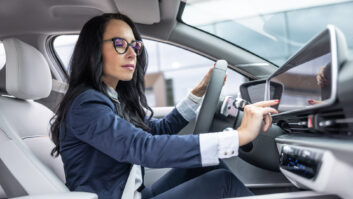One in a series of articles about the recently concluded EBU Digital Radio Summit.
 As more media and entertainment options integrate with the dashboard, how do motorists decide what to listen to, and what factors guide those decisions?
As more media and entertainment options integrate with the dashboard, how do motorists decide what to listen to, and what factors guide those decisions?
These questions were answered by BBC Researcher Aleksandra Gojkovic during the EBU Digital Radio Summit session, “Case Study: Audience Behavior in Car.” The summit was held online on Feb. 16, 2022.
Why study motorists?
The BBC’s decision to study motorists’ listening behaviors was spurred by the advent of web-connected car audio systems, and the lack of firm data explaining motorists’ content choices in the option-rich environment. “With a growing number of cars becoming increasingly connected, we looked at what this means for the BBC and where the threats and opportunities of this technology lie,” Gojkovic said.
The study was conducted in early 2020 using 20 subjects. They recorded their in-car listening behaviors on a mobile app. The BBC also installed dash cams that watched the car cabin, so that the actual behaviors and actions of drivers and their passengers were documented accurately.
Three factors
Not surprisingly, “our research uncovered a really complex ecosystem of needs and mediating factors that influence audio choices people make when in cars,” Gojkovic said.
Analysis of data collected identified three distinct trip characteristics that influenced listening choices: the length of the journey, the purpose of the journey, and the company inside the vehicle. This last factor was not just whether the driver was alone or with passengers, but who was along for the ride.

According to the BBC’s research, the expected length of a car journey has a substantial impact on the effort people make in selecting the best possible audio choices for their tastes and mood.
“Shorter journeys involve little preparation, and audio choices tend to be quicker and more [people] are more likely to resort to defaults,” said Gojkovic. “On longer journeys, there is a greater need to make the time count, and people are more likely to do things like tether [their devices to the car’s audio system] and listen to downloaded content, podcasts, and audiobooks.”
The purpose of the journey also affects audio choices. “Commuting drivers are looking to calibrate for the day ahead,” said Gojkovic. “They want to get into the zone, be prepared for their day of work, and get up to speed with what’s happening in the world. Homebound journeys can be more restorative. People are reflecting on the day that’s happened. They’re more contemplative anticipating an evening with friends, family, or an evening with their favorite books.”
When journeys are long, motorists want to get value from their listening experiences so that the time spent driving is not wasted. As a result, “they’re more likely to invest time in self-improvement, and they will listen to things like language learning on a speech podcast,” Gojkovic said.
The influence of passengers
The third factor is company: If there are passengers in the car, drivers will often choose audio that caters to their needs or to the group’s collective mood.
For example, when driving with children, the journey tends to be about either appeasing children or bonding with them, which is why drivers will choose audio that appeals to a young age group. If it’s a social group in the car out to have a good time, the “audio choices are crowd pleasers, and they tend to be non-contentious, light and frivolous,” said Gojkovic.
“Individual leisure drives are indulgent. They’re all about me and their needs are for either an energizing or a restorative experience. And companion drives are about connection and affinity,” she said.
One point worth noting: On social drives, “bonding is the overarching need, and audio is more likely to be background noise,” said Gojkovic. “When adult passengers are in cars, people are more likely to drive with no audio at all. … Whereas when alone, drivers are more likely to be actively engaged with the audio content they’re listening to, and in this case also more likely to listen to speech.”
Beyond these three factors, the ability of drivers to tether their smartphones to their audio systems (or not) and the success of algorithmically-curated web streams in providing content that suits their tastes and keeps them logged on also shape people’s in-car audio selections.
The bottom line: “More so than other media, audio choices in cars tend to be fast,” Gojkovic said concluding her talk. “And we’ll always gravitate towards the path of least resistance.”
Related stories:
- Human Connection Draws in Younger Listeners
- How CBC Radio Manages Its Wealth of Digital Content
- EBU Summit Engages in ‘Great Debate’ Over Radio Distribution
James Careless is an award-winning freelance journalist with experience in radio/TV broadcasting as well as A/V equipment, system design and integration. He has written for Radio World, TV Tech, Systems Contractor News and AV Technology among others. Broadcast credits include CBC Radio, NPR and NBC News. He co-produces/co-hosts the “CDR Radio podcast” and is a two-time winner of the PBI Media Award for Excellence.







